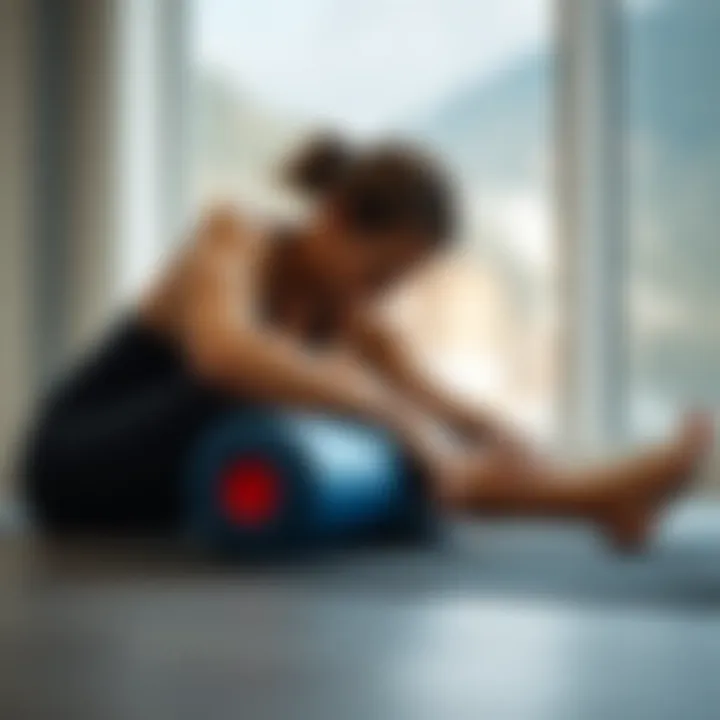Effective Strategies to Reduce Calf Muscle Cramps


Intro
Calf muscle cramps can feel like an unwelcome guest at a party. For watersports enthusiasts, they often show up uninvited, leaving behind a trail of frustration and discomfort. Imagine paddling away on a bright, sunny day, when suddenly, your calf seizes up, forcing you to halt mid-stroke, scrunching your face in agony. These scenarios are all too familiar, especially for those who spend hours engaged in activities like kayaking or jet skiing. Understanding the nuances of calf cramps is not just crucial for maintaining comfort; it's about optimizing performance and possibly avoiding injuries.
In this article, we will peel back the layers on calf muscle cramps, focusing on their origins and what steps can be taken to manage and prevent them effectively. Below, we will lay out practical strategies that can serve as valuable tools for athletes, coaches, and recreational watersport lovers alike.
Expert Insights
Latest Trends in Watersports
The landscape of watersports is constantly changing, influenced by innovations in technique and technology. Recent trends highlight a greater awareness of physical preparedness, emphasizing not just the joy of the sport itself but also the physiological limits of the human body. Understanding one’s body is crucial, as it can be the difference between pushing the limits and succumbing to discomfort or injury.
Research suggests that elite athletes are adopting tailored training programs that focus on flexibility and muscle endurance, which are essential in mitigating unexpected cramps. Integrative methods such as Pilates or yoga are gaining popularity among water athletes to improve flexibility, core strength, and muscle coordination in their legs, especially the calves.
Safety Protocols and Best Practices
When it comes to alleviating calf cramps, adhering to safety protocols and employing best practices can't be overstated. Here are some essential points to consider:
- Hydration: Dehydration is a classic trigger for muscle cramps. Drink plenty of water prior to and during your watersport activities.
- Warm-Up Routines: Dynamic stretching targeting the calf muscles can increase blood flow. Don't skimp on warming up before hitting the water.
- Cooling Down: Stretching post-activity is important. A quick calf stretch after a long paddle can work wonders for recovery.
- Listen to Your Body: If a cramp occurs, don’t ignore it. Stop and gently massage the muscle before you attempt to continue.
Remember, prevention is always better than cure. Investing time in understanding your body can pay off tremendously.
Equipment Recommendations
Must-Have Gear for Beginners
For those new to watersports, certain gear can play a role in boosting comfort and preventing cramps. Here’s a rundown of items that may help:
- Proper Footwear: Look for shoes designed specifically for watersports. They should offer support but also flexibility.
- Hydration Packs: Staying hydrated is key. A hands-free hydration pack can ensure you have access to water without interruption.
- Stretch Bands: These can be useful for at-home workouts, aiding in calf stretches and strengthening exercises.
Advanced Equipment for Pros
As experience grows, so do the demands of your equipment. Here’s what advanced athletes might want to invest in:
- Performance Wetsuits: These can improve body warmth and circulation during prolonged exposure to cold water, which may reduce the risk of cramping.
- High-Quality Paddle Boards: For paddleboarders, investing in a well-designed board that minimizes muscle strain can prevent over-exertion.
- Fitness Wearables: Technology such as heart rate monitors can provide insights into your body's responses during high-intensity activity and allow for better training adjustments.
By understanding both the evolution of the watersport landscape and the strategies to manage calf cramps, individuals can experience not only safer but also more enjoyable adventures on the water.
Foreword to Calf Muscle Cramps
Calf muscle cramps can catch anyone off guard, transforming an otherwise enjoyable activity into an uncomfortable struggle. Understanding these cramps is key for athletes, coaches, and recreational enthusiasts alike. Knowledge of the topic not only helps in quickly identifying and addressing the issue but also plays a critical role in enhancing overall performance during physical activities, especially in watersports.
Cramps in the calf muscles, those sudden and involuntary contractions, can be deeply impactful. The conscious awareness of why these cramps occur and how to prevent them can equip individuals with tools they need to maintain their performance levels. For athletes, particularly those who are active in watersports, each second counts, and sharp discomfort can detract from their game or performance.
Definition of Calf Muscle Cramps
Simply put, calf muscle cramps are intense, involuntary contractions of the muscles located in the lower leg. Often happening suddenly, these cramps can last anywhere from a few seconds to several minutes, varying in intensity.
The calf comprises two primary muscles—the gastrocnemius and the soleus. Cramps can involve one or both of these muscles, and they often manifest in the middle of exercise or even during rest. Although commonplace, the intensity of the pain can range significantly, often described as sharp or stabbing, leaving individuals momentarily immobilized.
Common Causes of Calf Muscle Cramps
Several factors contribute to the onset of calf cramps. Here's a rundown:
- Dehydration: Not drinking enough fluids can lead to electrolyte imbalances, often triggering cramps.
- Muscle fatigue: Overexerting the calves—especially during prolonged activities—can cause the muscles to spasm.
- Poor blood circulation: Insufficient flow of blood to the muscles can elevate the risk of cramping.
- Electrolyte imbalance: A deficit in key minerals such as potassium, calcium, and magnesium can interfere with muscle function.
- Inadequate stretching: Skipping warm-up routines or not focusing on flexibility can set the stage for unexpected cramps.
"An ounce of prevention is worth a pound of cure." Understanding potential triggers can significantly lower the chances of experiencing these painful episodes.
Recognizing the causes of calf cramps is essential for all who engage in physically demanding activities. With a clearer understanding, individuals can take proactive steps to protect themselves from these thwarting interruptions—keeping performance smooth and enjoyable.


Physiology of Muscle Cramps
Understanding the physiology behind muscle cramps is crucial for both prevention and effective management of calf cramps, especially for athletes and those who regularly engage in watersports. Muscle cramps are involuntary contractions of one or more muscles that can create not just discomfort but also hinder performance. By taking a closer look at the underlying physiological elements, one can identify strategies to mitigate their occurrence and address them swiftly when they happen.
Neuromuscular Factors
At the heart of muscle cramps lies the relationship between the nervous and muscular systems. When a muscle contracts, it is stimulated by electrical signals from the nervous system. If there's a disruption in this communication, such as overstimulation, the muscle fails to relax and remains in a contracted state.
Several key factors can contribute to neuromuscular issues:
- Electromagnetic interference: Signals can become misfired due to a variety of reasons, including fatigue and high-intensity activity.
- Nerve health: Conditions affecting nerve function, such as diabetes, can increase the likelihood of muscle cramps.
- Exercise intensity: Engaging in high-routine activities, like running or swimming, without adequate rest can overtax muscle capacities.
It's essential for athletes to pay attention to these neuromuscular dynamics and ensure sufficient recovery, as muscle fatigue and overuse are common culprits in triggering cramps. Listening to one’s body can often make the difference between performance enhancement and unwelcome discomfort.
Electrolyte Imbalance
Electrolytes—minerals like sodium, potassium, calcium, and magnesium—play a vital role in muscle function. They help maintain fluid balance and are pivotal in transmitting the electrical impulses that allow muscles to contract and relax properly. A notable electrolyte imbalance can set the stage for muscle cramps.
During intense activity, especially athletes engaged in endurance sports, significant sweating occurs, which can lead to loss of these critical minerals. Key points about electrolyte balance include:
- Sweat loss: A drop in key electrolytes like sodium or potassium can disrupt muscle functioning.
- Hydration strategies: Proper hydration, incorporating electrolyte-rich beverages, is crucial
- Dietary sources: Foods such as bananas (rich in potassium) and dark leafy greens (high in magnesium) can help fortify muscle health and prevent cramps.
Athletes should consider their hydration routines and dietary intake especially during prolonged activities. Maintaining a balanced intake of fluids and nutrients is not just an afterthought but a fundamental part of any training regimen aimed at sustaining performance.
"An ounce of prevention is worth a pound of cure."
In summary, understanding the neuromuscular mechanics and the importance of electrolytes is foundational for individuals looking to manage calf cramps effectively. By considering these physiological factors, one can adopt informed strategies that not only alleviate the cramps when they occur but also assist in preventing them in the first place.
For further information on muscle cramps, the National Institutes of Health provides extensive research at nih.gov.
Identifying Factors Contributing to Calf Cramps
Understanding the factors that contribute to calf muscle cramps is a crucial step in managing and alleviating these painful episodes. Identifying these elements allows athletes, coaches, and recreational enthusiasts to tailor their training and recovery strategies more effectively. When we grasp the origins behind these cramps, we can implement preventive measures that may not only reduce the frequency but also enhance overall performance in water sports and physical activities.
Dehydration and Its Effects
Dehydration is often overlooked, but it's a key player in cramping. Our muscles are like machines; they need lubrication to work smoothly. When water levels dip too low, muscle function can deteriorate, leading to cramping.
Not just a lack of water, but losing electrolytes through sweat compounds the issue. Sodium, potassium, and magnesium are essential for muscle contraction and relaxation. If you are engaging in watersports and sweating buckets, hydration must become a priority. Consider filtering your drinking water with an electrolyte-rich drink, particularly during or after intense activities.
"A hydrated body is less prone to cramping. Pouring a bit of extra attention into your hydration can work wonders."
Muscle Fatigue and Overexertion
Another significant factor is muscle fatigue stemming from overexertion. When muscles are pushed beyond their limits, they become exhausted and more prone to cramps. This can happen when engaging in prolonged or high-intensity activities without adequate rest or recovery. It’s crucial to listen to your body. If you're feeling like you're pushing against a brick wall, it's best to drop your pace a notch and allow your muscles to recover. Incorporating strength and conditioning exercises into your training regimen can also bolster muscular endurance, making them less susceptible to fatigue. Pre-training assessments can also help in preparing your body for the demands of any given activity.
Environmental Influences
Lastly, environmental factors play a role you might not consider right off the bat. Temperature, humidity, and terrain can have a significant impact on muscles. Warm, humid conditions can increase sweat loss, leading to dehydration. On the other hand, cold conditions can cause muscles to tighten.
When training, keep an eye on the weather forecast. If you're in a humid environment, make sure you’re sipping water frequently, and if it’s too cold, layer up properly to keep your muscles warm and functioning optimally. Remember, the surroundings can either be your greatest ally or your worst enemy when it comes to muscle health.
Preventive Measures to Reduce Cramps
Preventing calf muscle cramps is not just about immediate relief; it's about managing your body in a way that minimizes the chance of those sudden, painful contractions. Cramps can hit like lightning, disrupting your workout and affecting your performance in watersports. Therefore, implementing proactive strategies can make all the difference. It allows athletes to focus on their skill rather than battling through pain. By adopting simple yet effective preventive measures, one can significantly reduce the frequency and intensity of these cramps.
Hydration Strategies
Hydration is a cornerstone strategy for preventing calf cramps. When you’re working hard, your body requires water like a car needs fuel. Dehydration can lead muscle fibers to cramp up, making good hydration a necessity for performance and comfort in athletic activities.
Importance of Regular Fluid Intake
Regular fluid intake does more than just quench your thirst; it facilitates crucial bodily functions and impacts muscle performance directly. Staying hydrated helps maintain blood volume, thereby ensuring that oxygen-rich blood flows freely to your muscles. Without this crucial fluid, muscle contraction and relaxation can get interrupted, leading to cramps.
Moreover, it is prudent to ensure that you're sipping water throughout the day, not just during intense workout sessions. The unique feature of regular fluid intake is its role as a continuous support system; it provides your muscles with the hydration they require to function efficiently. As a result, those athletes who habitually chug down water may find themselves with a noticeable advantage in terms of endurance and performance.


Electrolyte Solutions
Consume electrolyte solutions in tandem with water to give your body an extra layer of protection against cramps. These beverages replace minerals that can be lost through sweat, such as sodium, potassium, and magnesium. Each of these electrolytes plays a vital role in muscle function. Without them, your body is like a car running on empty; muscle contractions may become erratic and lead to cramping.
What makes electrolyte solutions a solid choice is their refreshing taste and the balanced nutrients they provide. They make a favorite among athletes because they not only hydrate but also remedy any imbalances that could be lurking just beneath the surface. Consider incorporating them into your hydration routine, especially in strenuous activities.
Proper Warm-Up Techniques
Warming up should feel like priming your engine for a race. It helps in preparing your muscles by increasing blood flow and flexibility. A proper warm-up for about 10 to 15 minutes can include dynamic stretches or gentle jogging. Engaging your body in this manner can reduce muscle tightness, making each subsequent movement smoother. Calf muscles, in particular, benefit from focused attention during this phase, as they often face the brunt of intense activity.
Stretching and Strengthening Exercises
Static stretching before and after exercise helps keep muscles long and supple, while strengthening exercises target the calf muscles specifically. Consider doing calf raises, where you lift your body with the balls of your feet, as a method for improving strength and endurance of the calf muscles. Implementing such exercises not only bolsters the muscle's resistance to cramps but also enhances overall performance.
Integrate these strategies into your routine, and you'll be well on your way to enjoying your watersport activities without the nagging worry of cramps dulling your edge. Always remember, the goal is to keep your muscles happy and functioning optimally.
Immediate Relief Techniques for Calf Cramps
Calf muscle cramps can strike unexpectedly, turning an otherwise enjoyable activity into a painful struggle. Understanding how to handle these cramps immediately is crucial for athletes, coaches, and recreationists, as the right response can make a world of difference in regaining comfort and continuing the pursuit of physical activity. Immediate relief techniques are tailored to address the cramp quickly, allowing individuals to alleviate discomfort and return to action as soon as possible.
Gentle Stretching Methods
One of the most effective ways to beat a calf cramp is through gentle stretching. When a cramp occurs, it’s like the muscle is involuntarily clenching up, tight as a drum. Stretching helps to lengthen the muscle back to its relaxed state. A simple calf stretch can be accomplished by standing a few feet from a wall, placing your hands on it at shoulder height, and leaning forward while keeping your back leg straight with your heel on the ground. Feel that delightful stretch? Hold it for about 15 to 30 seconds.
However, stretching is not just limited to wall-supported versions. You can also sit down, extend your legs, and gently pull your toes towards you while keeping your knee straight. Not only does it release the tension, but it also gets the blood flowing back into the area.
It's important not to push too hard. Gentle movements should be the name of the game—avoid any jerking motions as they may increase the cramping.
Massage and Rituals for Relief
Another excellent remedy involves good old-fashioned massage. By using your hands or a massage tool, apply pressure to the cramped muscle. It’s like sending in the cavalry to rescue your leg! Circular kneading motions or even gentle presses can bring immediate comfort. For those who enjoy self-massage, try pressing down firmly on the calf while flexing and relaxing the foot.
Alongside massage, there are rituals that many find helpful. Placing a warm towel around the cramped muscle can create a comforting sensation, working to relax those tight fibers. Furthermore, practitioners of certain disciplines, such as yoga, may utilize specific poses—like the downward-facing dog or the child’s pose—to bring gentle stretching and relaxation simultaneously.
“Many athletes swear by foam rolling before and after workouts to prevent cramps and release tension.”
Incorporating these techniques into your routine can prepare your muscles better for workouts, potentially reducing the chances of cramps in the first place.
Application of Heat and Cold Therapy
Heat and cold therapy serves as another avenue for immediate relief. When the cramp strikes, some find that applying a warm compress to the area eases the tension considerably. Heat enhances blood flow, encouraging those overworked muscles to relax. This could mean using a hot water bottle, a warm towel, or even a heating pad if available.
Conversely, cold therapy can also play a pivotal role, especially if the pain feels sharp and throbbing. An ice pack or a cold compress can help to numb the sensitive spots and reduce inflammation. Just be careful—never apply the cold directly to the skin; always wrap it in a cloth to avoid frostbite.
Choosing which therapy to pursue can depend on personal preference and the specific symptoms being dealt with. It may take some trial and error to find what feels best for the individual.
In summary, knowing how to relieve calf cramps can significantly enhance your athletic experience. Techniques such as gentle stretching, massage, and the application of heat or cold are vital tools for anyone participating in sports or physical activities. The next time a cramp tries to derail your efforts, you’ll be well-equipped to handle it with grace and efficiency.
Long-Term Solutions for Managing Cramps
Addressing calf muscle cramps is not just about finding immediate relief; it's crucial to look at long-term management strategies. By adopting lifestyle changes and nutritional adjustments, individuals can reduce the frequency and severity of these pesky cramps. The benefits include improved athletic performance, enhanced recovery times, and ultimately a better overall quality of physical activity. This section delves deeper into two primary areas of focus: lifestyle adjustments and nutritional considerations.
Lifestyle Adjustments
To tackle calf cramps effectively in the long run, embracing certain lifestyle adjustments can yield significant improvements. One essential adjustment is incorporating regular physical activity into your routine. It doesn’t have to be an Olympic marathon training program; even simple activities like walking, cycling, or swimming can keep your calf muscles flexible and strong.
- Stretch Regularly: Integrating a stretching routine before and after exercise helps keep muscle fibers flexible.
- Maintain a Balanced Exercise Regimen: Alternate high-intensity workouts with lower-intensity sessions to avoid overexertion.
- Pay Attention to Rest: Ensure proper recovery time after strenuous activities. Overworking muscles can lead to cramping.
- Wear Proper Footwear: Choose shoes that provide adequate support and fit well. Poor shoe choices can exacerbate foot and calf issues.
By introducing these adjustments, not only can one reduce the chance of cramps but also enhance overall physical endurance and comfort during activities. Regular assessment of one’s physical condition can also unveil underlying issues that may need attention, allowing for more personalized solutions.


Nutritional Considerations
Nutrition plays a pivotal role in muscle function and overall health. For those looking to strengthen their muscular responses and diminish cramps, focusing on key nutrients is essential.
Role of Potassium and Magnesium
Potassium and magnesium are critical minerals that directly influence muscle contractions and nerve function. Potassium helps in regulating fluid levels and is crucial for nerve signalling, which is necessary for muscle contractions to occur smoothly. Magnesium, on the other hand, assists in muscle relaxation, making it equally important for maintaining muscle health.
- Why It’s Beneficial: People often prefer potassium and magnesium-rich foods because of their dual roles in both preventing cramps and aiding recovery.
- Unique Features: Sources like bananas, avocados, and leafy greens are not only rich in these minerals but also conveniently available. This makes them an easy addition to daily diets, helping to secure long-term benefits for muscle function.
- Advantages: By ensuring adequate intake of these nutrients, athletes can significantly lessen their chances of experiencing cramps, which is especially beneficial during intensive training periods.
Balancing Diet for Muscle Function
A well-balanced diet tailored towards muscle function goes beyond simply including potassium and magnesium. It emphasizes the right mix of carbohydrates, proteins, and healthy fats. Each component contributes to energy generation, muscle repair, and overall performance.
- Key Characteristics: A balanced diet encourages the intake of various food groups, ensuring that all essential nutrients are available. Incorporating lean proteins, whole grains, and healthy fats can create a solid foundation for physical activity.
- Why It’s a Popular Choice: Many find that properly fueling their bodies helps not just with avoiding cramps but also boosts energy, stamina, and recovery.
- Unique Features: This holistic approach means that every meal contributes to better muscular health, so sticking to a balanced regimen can reduce the risk of sudden cramping spells.
By integrating these nutritional strategies within their daily routines, athletes and physical activity enthusiasts can make substantial strides in securing an active lifestyle free from the annoyance of calf cramps.
Role of Professional Guidance
Navigating the often choppy waters of calf muscle cramps requires more than just basic remedies. Engaging with professional guidance can provide crucial insights and personalized strategies tailored to individual needs. Athletes and recreational enthusiasts alike can benefit from expert advice, not only in managing cramps but also in enhancing overall physical performance and preventing future occurrences.
Consultation with Sports Medicine Experts
Consulting with a sports medicine expert is akin to having a seasoned captain at the helm. These professionals possess in-depth knowledge of biomechanics, nutrition, and injury prevention specific to athletes. When encountering persistent calf cramps, a sports medicine expert can provide comprehensive assessments to identify the underlying causes. This includes evaluating exercise techniques, training routines, and previous injury history.
During consultations, it can be useful for individuals to discuss any noticeable patterns or triggers related to their cramps. For instance, some might find that cramps typically strike during certain activities or after prolonged periods without stretching. Based on this information, the expert can develop tailored strategies that could include specific exercises, adjustments to training intensity or duration, and nutritional recommendations to address any deficiencies.
Additionally, medical experts often stay informed about the latest advancements in sports science, ensuring that their recommendations align with cutting-edge practices. By taking this step, athletes can equip themselves with tools not just for managing cramps, but for achieving peak performance in their respective sports.
Physical Therapy Options
Physical therapy often plays a pivotal role in managing calf muscle cramps, acting as the bridge between discomfort and recovery. A trained physical therapist can design customized rehabilitation programs focusing on strength, flexibility, and endurance.
During a typical session, the therapist might incorporate a variety of methodologies:
- Manual therapy techniques, where hands-on manipulation of the muscles can alleviate tension and improve circulation.
- Targeted stretching routines to enhance flexibility, which may reduce the frequency of cramps.
- Strengthening exercises aimed at critical muscle groups that support the calves, ensuring they can better withstand physical exertion over time.
Incorporating these aspects into a regular routine may yield positive results over the long haul. A good physical therapist will ensure that the exercises align with the specific sports activities or routines engaged by the individual, emphasizing the need for individualization in treatment plans.
Moreover, many physical therapy clinics provide education about proper hydration techniques and nutrition, which are essential components for muscle function. In essence, physical therapy not only addresses the symptoms but lays the groundwork for comprehensive athletic improvement.
Engaging with these professionals provides athletes and recreationalists with the knowledge and risks needed to tackle calf cramps effectively and maintain their enthusiasm for engaging in sports.
"Proper guidance from experts is a necessary investment for anyone serious about their athletic journey."
In summary, obtaining professional guidance through sports medicine consultation and physical therapy is indispensable for anyone looking to not just alleviate calf cramps but improve their overall athletic performance.
The End
Calf muscle cramps are not just an inconvenience; they can sideline athletes, disrupt routines, and dampen overall enjoyment in physical activities. As explored throughout this article, knowing how to manage and prevent these cramps can significantly enhance both performance in watersports and daily life. It's essential for athletes, coaches, and recreationists alike to have a toolkit of strategies ready to deploy at a moment’s notice.
Summary of Key Strategies
To recap, several key strategies emerge from this guide:
- Hydration: Keeping the body well-hydrated is crucial. Regular fluid intake helps maintain electrolyte balance, drastically reducing the chances of muscle cramps.
- Proper Warm-Up: A warm-up routine tailored for the specific demands of watersports prepares your muscles and provides a buffer against sudden cramps.
- Stretching and Strengthening: Incorporating targeted exercises into your training that focus on calf muscles can bolster their endurance and resilience.
"Prevention is better than cure"; this couldn't be more valid when it comes to calf cramps.
Additionally, when cramps do occur, recognizing and using immediate relief techniques such as gentle stretching or massage can provide quick escape from discomfort. It's worth noting that even long-term solutions such as a balanced diet rich in potassium and magnesium are not to be overlooked; they contribute significantly to muscle health.
Final Thoughts on Managing Calf Cramps
Ultimately, calf cramps should inspire athletes to be proactive rather than reactive. By understanding the physiology behind cramps and employing the strategies discussed here, individuals can take charge of their physical health. A conscious approach to hydration, nutrition, and conditioning can act as the strings that tie everything together, leading to a more enjoyable experience in aquatic environments.
As you immerse yourself in your next water-based activity, remember that these strategies are not just a checklist but rather a lifestyle change. Think of your calves as your engine; treat them right, and they will carry you far.







